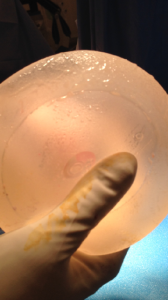SILICONE BREAST GEL BLEED
Posted On: August 10, 2014 Author: The Office of Dr. Stuart Linder Posted In: Breast Implants, Breast Revision, Breast topics, Ruptured Implant
 We perform breast augmentations weekly. Both saline and silicone gel implants are used in our Beverly Hills Surgery Center. Interestingly, this is a case example of a silicone gel implant bleed.
We perform breast augmentations weekly. Both saline and silicone gel implants are used in our Beverly Hills Surgery Center. Interestingly, this is a case example of a silicone gel implant bleed.
The patient underwent augmentation mammoplasty with silicone textured implants under the muscle by a different surgery approximately 13 years ago. Although the MRI does not show specific rupture of the implant and that the shell of the implant is intact, upon removal of the implant there is significant silicone gel bleed. What that simply means is there are micro pores within the shell of the silicone implant that actually bleed small droplets of silicone. Examination of the implant, as can be seen by the photographs, shows this light silicone layer external to the shell. Upon pressing on it with your finger, a small amount of silicone appears to be cohesive and sticky and it appears there are small micro droplets throughout the shell. Silicone gel bleed is the usual process of all silicone implants over time. The silicone gel bleed does increase risk of capsular contracture, calcifications, hardening and scar tissue formation. Silicone gel bleed over time can lead to both intra and extracapsular spread of the silicone, with spread furthermore to lymphatics, including the axillary lymph nodes.
The general message from this blog is that simply because your silicone implants do not show a specific rupture on MRI, does not mean there is not bleed and silicone leakage external to the implants. As a result, I still believe that implants should be replaced every 10 to 15 years in order to reduce the silicone bleed and its consequences, including capsular contracture, calcification, calcified granulomas and scar tissue formation.